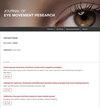Introduction to the Special Thematic Issue "Virtual Reality and Eye Tracking"
IF 1.3
4区 心理学
Q3 OPHTHALMOLOGY
引用次数: 0
Abstract
Technological advancements have made it possible to integrate eye tracking in virtual reality (VR) and augmented reality (AR). Many new VR/AR headsets already include eye tracking as a standard feature. While its application previously has been mostly limited to research, we now see installations of eye tracking into consumer level VR products in entertainment, training, and therapy. The combination of eye tracking and VR creates new opportunities for end users, creators, and researchers alike: The high level of immersion – while shielded from visual distractions of the physical environment – leads to natural behavior inside the virtual environment. This enables researchers to study how humans perceive and interact with three-dimensional environments in experimentally controlled, ecologically valid settings. Simultaneously, eye tracking in VR poses new challenges to gaze analyses and requires the establishment of new tools and best practices in gaze interaction and psychological research from controlling influence factors, such as simulator sickness, to adaptations of algorithms in various situations. This thematic special issue introduces and discusses novel applications, challenges and possibilities of eye tracking and gaze interaction in VR from an interdisciplinary perspective, including contributions from the fields of psychology, human-computer interaction, human factors, engineering, neuroscience, and education. It addresses a variety of issues and topics, such as practical guidelines for VR-based eye tracking technologies, exploring new research avenues, evaluation of gaze-based assessments, and training interventions.专题特刊 "虚拟现实与眼动跟踪 "导言
技术的进步使得在虚拟现实(VR)和增强现实(AR)中整合眼动追踪技术成为可能。许多新型 VR/AR 头戴式设备已经将眼动追踪作为一项标准功能。以前,眼动仪的应用主要局限于研究领域,而现在,我们看到眼动仪已被安装到娱乐、培训和治疗等消费级 VR 产品中。 眼动仪与 VR 的结合为最终用户、创作者和研究人员创造了新的机遇:高度的沉浸感--在屏蔽物理环境的视觉干扰的同时--导致虚拟环境中的自然行为。这使研究人员能够在实验控制、生态有效的环境中研究人类如何感知三维环境并与之互动。与此同时,VR 中的眼动跟踪对注视分析提出了新的挑战,需要在注视互动和心理研究方面建立新的工具和最佳实践,从控制影响因素(如模拟器病)到在各种情况下调整算法。本专题从跨学科的角度介绍和讨论了眼动跟踪和 VR 中注视交互的新应用、挑战和可能性,包括心理学、人机交互、人为因素、工程学、神经科学和教育领域的贡献。它探讨了各种问题和主题,如基于 VR 的眼球跟踪技术的实用指南、探索新的研究途径、评估基于注视的评估和培训干预措施。
本文章由计算机程序翻译,如有差异,请以英文原文为准。
求助全文
约1分钟内获得全文
求助全文
来源期刊

Journal of Eye Movement Research
OPHTHALMOLOGY-
CiteScore
2.90
自引率
33.30%
发文量
10
审稿时长
10 weeks
期刊介绍:
The Journal of Eye Movement Research is an open-access, peer-reviewed scientific periodical devoted to all aspects of oculomotor functioning including methodology of eye recording, neurophysiological and cognitive models, attention, reading, as well as applications in neurology, ergonomy, media research and other areas,
 求助内容:
求助内容: 应助结果提醒方式:
应助结果提醒方式:


